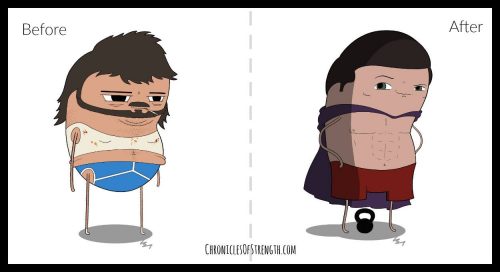
The guy on the left kept getting distracted by punks with foam darts. The guy on the right ignored these silly skirmishes and stayed focused for WAR.
In the War Against Fatness, I have identified 3 distinct camps. Each one has its own battles that must be fought, as well as distractions that must be ignored.
Distractions, to reference an odd mixed-metaphor from last post, are all the “Trees Not Worth Sweating Over.” They might look like a battle but will likely end up draining you of energy and focus, ultimately decreasing your likelihood of success against the real enemy.
My goal in this post is to help you determine your camp and plan accordingly so that you can win your war.
[Obvious and hopefully unnecessary disclaimer: You are an individual. You may be an exception. Hire a coach!]
Camp A: Needs to lose significant weight.
Description: Note the word needs. Fat-loss–or even generic weight loss–is the single most impactful thing this person can do to increase their health/quality of life/longevity. If you take a hard look at the risk factors related to a high body fat percentage, you’ll see that, pretty much regardless of any other health or nutrition endeavors, obese folks NEED to lose weight.
Battles Worth Fighting:
-PORTION CONTROL via calorie-counting or meal templates
**FOOD LOGS are the…AK47? bazooka? a-bomb?…of this war.**
-ADDING lean protein and greens
-Limiting high-sugar and high-fat foods
-Sometimes, total food group elimination (to aid ease/promote simplicity)
For these dieters, the priority is to reach caloric deficit. That is, reduce calories such that one is burning more than one is consuming. The goal is to achieve a moderate weekly deficit, perhaps with some variation on a daily basis. (For instance, intelligent fasting and/or caloric cycling are useful strategies that manipulate the daily deficit.)
I’m slowly coming around to the idea that, for these types, it’s best to reach that deficit however they darn well please. Diet sodas instead of regular sodas? Eek, fine. Baked potato chips instead of fried? So be it. Nonfat, no-sugar creamer instead of a blended coffee dessert? I can deal with that.
Too many rules and restrictions understandably make the task of caloric deficit overwhelming. It’s tough enough to cut calories without worrying about all the other noise.
[I don’t know that I will ever actually recommend these artificial stand-ins for high-quality, nutrient-dense real foods, but I totally see their purpose in the case of necessary weight loss.]
Distractions:
- Gimmicky diets that seem too good to be true — They usually are.
- Convenience foods labeled “healthy” — Unless you know what you’re looking for on the nutrition label, these can often be misleading. Also, “healthy” foods like dates, figs, oats, and nuts join together for “healthy” snack bars that pack a meals’ worth of calories mostly from sugars and fats. “Healthy” and “nutritious” are not synonymous with “low-calorie” or “weightloss-friendly.”
- Gluten-free diets/products (obviously unless there are digestion-related issues) — “Gluten-free” does not indicate “healthy” nor “weightloss-friendly.” It simply means that the product does not contain a specific type of protein (a protein which is found in natural, nourishing foods); often times, the products will contain additional ingredients to boost flavor due to the fact that gluten-free grains (like rice) tend to be fairly bland compared to the more robust flavor of, say, whole grain barley or rye.
- Be wary of fad diets unless yours is being overseen by a professional. Extreme diets can be super-beneficial for those with significant weight to lose; however, without guidance, it can be difficult to crash and burn.
- Getting caught up in worrying about things like eliminating white potatoes in lieu of sweet potatoes. Both are carbs. Either is fine if you are looking for a carbohydrate source. Neither is fine if you’ve already eaten enough carbs.
- Most people who need to lose considerable weight will do well with a total lifestyle overhaul. They just bite the bullet, go all out, and get rapid results. THEN they are in a different camp and can begin focusing on “healthy eating” & how that relates to them personally.
- For now, avocado toast will not aid weightloss any more than buttered toast will. And if leaves the dieter still craving butter, it might even backfire.
Bottom Line: Go all out. Do [pretty much] whatever you need to do in order to cut calories while still maintaining some sanity by ensuring you sometimes experience fullness (with veggies and fiber) and sometimes experience deliciousness (through a sprinkling of your preferred sources of fatty, sugary goodness).
“Camp A” Not Your Camp?
Sorry ’bout that.
Next post, I’ll delve into the other two camps.
Camp B: Wants to lose the last few pounds and/or get super-lean.
For these dieters, the focus will need to be on tricking the body to burn fat for fuel.
Camp C: Aims to achieve general performance and/or lifestyle goals.
For these dieters, the focus will shift toward sustainability and individualized healthy eating.
In the meantime, regardless of your camp, try out this…
5-Minute Sweaty
60s plank hold total, 15s each of R arm lifted, R leg lifted, L arm lifted, L leg lifted;
120s cycling through this modified burpee sequence: from plank, jump feet to hands, rise from squat to vertical jump, land in squat, plant hands, shoot legs back to plank, lower to forearm plank, push to standard plank, jump feet to hands, rise from squat to vertical jump, etc. [It’s a burpee with an added drop to forearm plank for some added burn. No push-up.]
30s plank with alternating R knee to R elbow (or shoulder!) and R knee to L elbow;
30s plank with alternating L knee to L elbow (or shoulder!) and L knee to R elbow;
60s cycling through same modified burpee sequence described above.
P.S. Like getting sweaty? Of course you do! That’s why you’re here! Grab Pat’s newest, bestest, sweatiest, beastliest compilation of 101kettlebellworkouts.